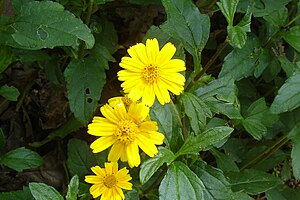Sphagneticola trilobata
| Sphagneticola trilobata | ||||||||||||
|---|---|---|---|---|---|---|---|---|---|---|---|---|

Sphagneticola trilobata |
||||||||||||
| Systematics | ||||||||||||
|
||||||||||||
| Scientific name | ||||||||||||
| Sphagneticola trilobata | ||||||||||||
| ( L. ) Pruski |
Sphagneticola trilobata is a species of the sunflower family (Asteraceae).
description
Appearance and leaf
Sphagneticola trilobata grows as a creeping or prostrate, mat-forming, perennial herbaceous plant . The stalk, which is round in cross section, is rooted at the nodes (nodes) and reaches lengths of 10 to 30, rarely up to 40 centimeters. Its surface is hairy or bald, and rarely scaly. The inflorescence-bearing section of the stem is ascending and coarsely curly to spreading, coarse hairy or sometimes almost glabrous.
The somewhat fleshy leaves are arranged opposite one another on the stems and have a stem that is no longer than 0.5 centimeters. The leaf blade is usually 4 to 9 centimeters long, but also up to 18 centimeters and a width of 1 to 5 centimeters elliptical to lanceolate and usually has a pair of lateral triangular leaf lobes. The surfaces of the leaf blades are smooth or sparsely hairy, sometimes scaly. The edges of the blades are inconspicuously serrated or serrated and the base of the blade is wedge-shaped while the tip of the blade is pointed.
Inflorescence, flower and fruit
The inflorescence stem is 3 to 10 inches long. There are basket-shaped inflorescences formed. The lanceolate bracts form a bell-shaped hemispherical involucre with a height of about 1 centimeter . The flower heads contain 8 to 13 6 to 15 millimeters long tongue (= ray) and 4 to 5 millimeter long tubular flowers (= disc flowers). The pappus consists of a crown of frayed scales. The warty achenes are 4 to 5 millimeters long and not all mature in cultivated specimens.
Chromosome number
The number of chromosomes is 2n = 56.
Occurrence
Originally Sphagneticola trilobata is widespread from Mexico to Central America and on the Caribbean islands . It is now a neophyte in the rest of the Neotropics , in southern and western Africa, on Mayotte , in India, Thailand, Indonesia, China, Taiwan, in Australia and on numerous islands in the Pacific .
use
It is used as a ground cover as an ornamental plant.
Spread
In many areas of the world the species is rated as an invasive plant and according to the Invasive Species Specialist Group (ISSG) of the IUCN Species Survival Commission , Sphagneticola trilobata is one of the 100 most dangerous neobiota worldwide.
Taxonomy
It was first published in 1759 under the name ( Basionym ) Silphium trilobatum by Carl von Linné in Systema Naturae , Editio Decima, 2, p. 1233; there “trilobatu” written. The new combination to Sphagneticola trilobata (L.) Pruski was published in 1996 by John Francis Pruski in Memoirs of The New York Botanical Garden , Volume 78, p. 114. Other synonyms of Sphagneticola trilobata (L.) Pruski are, for example: Acmella brasiliensis Spreng. , Acmella spilanthoides Cass. , Buphthalmum repens Lam. , Buphthalmum strigosum Spreng. , Complaya trilobata (L.) Strother , Polymnia carnosa Poir. , Polymnia carnosa var. Aspera (Rich.) Poir. , Polymnia carnosa var. Glabella (Rich.) Poir. , Polymnia carnosa var. Triloba (Rich.) Poir. , Seruneum paludosum (DC.) Kuntze , Seruneum trilobatum (L.) Kuntze , Sphagneticola ulei O. Hoffm . , Stemmodontia trilobata (L.) Small , Thelechitonia trilobata (L.) H.Rob. & Cuatrec. , Verbesina carnosa M.Gómez , Verbesina carnosa var. Aspera (Rich.) M.Gómez , Verbesina carnosa var. Triloba (Rich.) M.Gómez , Wedelia brasiliensis S.F. Blake , Wedelia carnea Rich. , Wedelia carnosa rich. ex explos. , Wedelia carnosa var. Aspera Rich. , Wedelia carnosa var. Glabella Rich. , Wedelia carnosa var. Triloba Rich. , Wedelia crenata Rich. Poepp , Wedelia paludicola . & Endl. , Wedelia paludosa DC. , Wedelia triloba (Rich.) Bello , Wedelia trilobata (L.) Hitchc.
Individual evidence
- ↑ a b c d e f Sphagneticola trilobata (herb). Global Invasive Species Database website, accessed December 23, 2014 .
- ↑ a b Asteraceae . Sphagneticola. In: Wu Zhengyi, Peter H. Raven, Hong Deyuan (eds.): Flora of China . Asteraceae. Volume 20-21. Science Press and Missouri Botanical Garden Press, Beijing and St. Louis 2011, Sphagneticola trilobata , p. 870 (English, Sphagneticola trilobata - online - this printed work is online with the same text).
- ↑ John L. Strother: Myrsinaceae . Asteraceae . In: Flora of North America Editorial Committee (Ed.): Flora of North America North of Mexico . Magnoliophyta: Asteridae (in part): Asteraceae, part 3. Volume 21. Oxford University Press, New York a. a. 2009, ISBN 0-19-530565-5 , Sphagneticola trilobata , p. 126 (English, Sphagneticola trilobata - online - this work is online with the same text).
- ↑ Sphagneticola trolobata at Tropicos.org. In: IPCN Chromosome Reports . Missouri Botanical Garden, St. Louis
- ^ A b Sphagneticola in the Germplasm Resources Information Network (GRIN), USDA , ARS , National Genetic Resources Program. National Germplasm Resources Laboratory, Beltsville, Maryland.
- ↑ Sphagneticola trilobata at Tropicos.org. Missouri Botanical Garden, St. Louis, accessed December 23, 2014.


